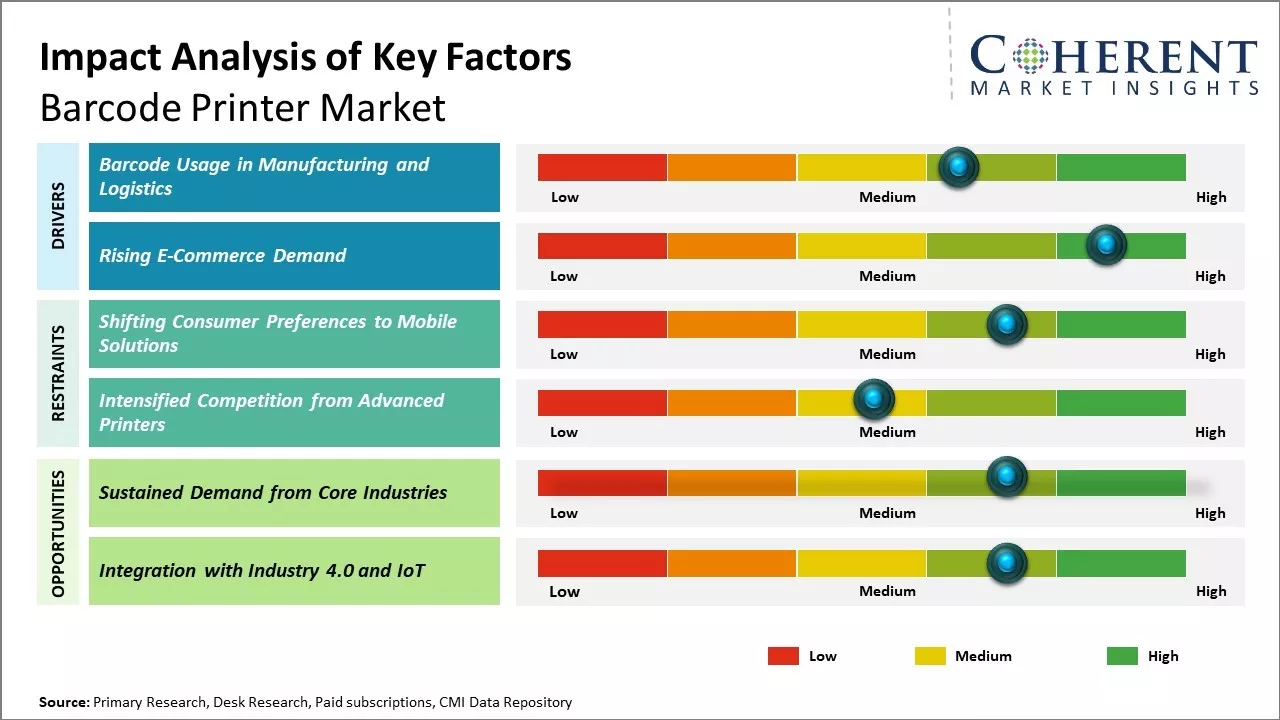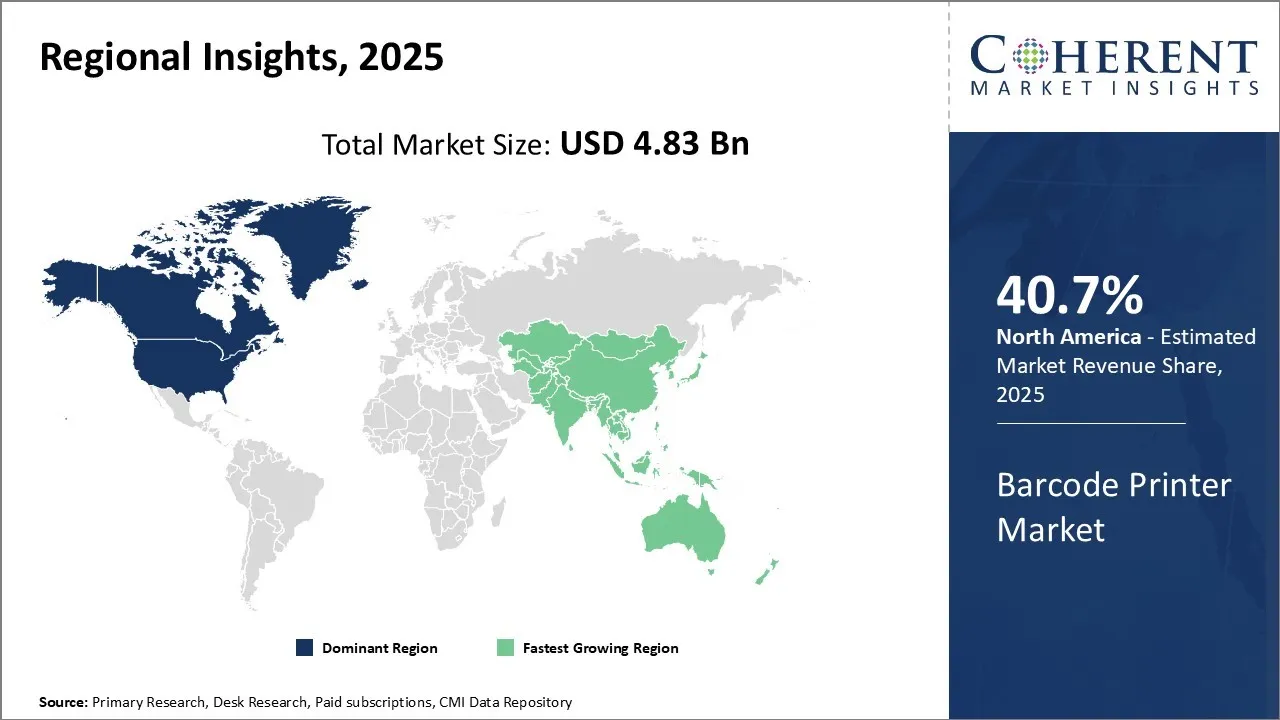The global barcode printer market is estimated to be valued at USD 4.83 Bn in 2025 and is expected to reach USD 7.71 Bn by 2032, exhibiting a compound annual growth rate (CAGR) of 6.9% from 2025 to 2032.

To learn more about this report, Download Free Sample
The barcode printer market is expected to witness high growth, owing to the rising adoption of barcode scanners across several industries including retail, manufacturing, and e-commerce. With automation becoming increasingly popular, the demand for barcode printers is growing significantly. They help in inventory management, supply chain automation, and tracking of goods throughout the product lifecycle.
Additionally, ongoing technological advancements in printer features such as wifi connectivity, mobility, and interface compatibility with multiple operating systems are expanding the potential of barcode printers beyond traditional point-of-sale uses. Faster printing capabilities and lower maintenance needs are further driving their uptake among small businesses and warehouses.
|
Current Events |
Description and its impact |
|
Geopolitical Supply Chain Disruptions |
|
|
U.S.–China Tech Trade Tensions |
|
Uncover macros and micros vetted on 75+ parameters: Get instant access to report
The barcode printer market is steadily being driven by the widespread adoption of barcode technology in the manufacturing and logistics industries. Barcodes have become an essential part of the supply chain management process, being used at each step to accurately track materials, components, and finished goods. Their scanning allows real-time visibility into inventory levels and product movements. This enables just-in-time manufacturing and reduces risks of over- or under-stocking. With global supply chains now the norm, the ability to scan barcodes on arrival and dispatch of shipments is critical to maintaining efficiency.
For instance, in November 2023, SATO Corporation which is a provider of auto-ID solutions, in collaboration with Mitsubishi Electric Corporation which is an electronics and electrical equipment manufacturing company, introduced sample programs for Mitsubishi Electric MELSEC sequencers. These programs aim to automate label printing by sending commands to SATO label printers at specific events in the production line.
The exponential growth of the e-commerce industry is a major factor propelling the barcode printer market. Almost all warehousing and fulfilment processes for online retail depend on the accurate scanning of shipping labels, packages, and pallets. This allows sorting packages destined for different locations, prioritizing urgent orders, managing inventory spread across multiple sites, and automating shipping notifications. Efficient e-fulfilment which relies on uniform barcode standards that ensure seamless data exchange between retailers, carriers and customers.
For instance, in the first quarter of 2025, U.S. retail e-commerce sales reached approximately USD 300.2 billion, marking a 6.1% increase compared to the first quarter of 2024. This consistent growth underscores the ongoing reliance on robust barcode printing solutions to manage the increasing volume and complexity of online orders, from fulfillment to last-mile delivery. The substantial presence of Small and Medium-sized Enterprises (SMEs) also plays a crucial role, as they provide essential components and services to major players like Zebra Technologies Corp., Honeywell International Inc., and SATO Holdings Corporation, further contributing to the overall expansion of the market.

To learn more about this report, Download Free Sample
The Global Barcode Printer Market continues to thrive, fueled by the essential role barcodes play across diverse sectors. Key industries like retail, manufacturing, and logistics maintain a consistent and high demand for barcode printers, as these devices are fundamental for efficient inventory management, streamlined operations, and accurate product tracking. Beyond these core sectors, significant growth opportunities are emerging from new industries and regions increasingly adopting barcode technologies, driven by digitalization and the need for enhanced traceability.
The market is set for innovation by leveraging Industry 4.0 and IoT, enabling the development of advanced printer models with integrated data analytics for predictive maintenance and remote management capabilities, further optimizing operational efficiency and reducing costs. This evolving landscape positions the market for robust expansion.
In terms of printer type, industrial barcode printers is expected to contribute the highest share of 58.6% in 2025, owing to their high reliability and durability. Industrial barcode printers are designed to withstand demanding industrial environments with moisture, dust, vibrations, and temperature extremes. They are built with metal casing and commercial-grade components that offer maximum protection to the printing mechanism. Their durable design allows continuous printing over long shifts with minimal downtime. Many industrial barcode printers are programmed for 24/7 operation and come with auto-calibration features for consistency.
The Barcode Printer Market encompasses various types of barcode printing solutions, including Industrial Barcode Printers, Mobile Barcode Printers, and other specialized devices. Mobile Barcode Printers, on the other hand, provide the flexibility of on-the-go printing, enabling users to generate labels and tags directly from mobile devices. The category of "Others" includes desktop barcode printers and compact models catering to specific industry needs. These printers play a crucial role in automating data entry and tracking processes across diverse sectors, enhancing inventory management, and improving overall operational efficiency for businesses of all sizes.
In terms of printing technology, thermal transfer is expected to contribute the highest share of 34.62% in 2025, due to its capacity for high speed and quality printing. Thermal transfer printers are well-suited for applications that require printing of thousands of labels or tags per day. Thermal transfer also allows customized printing with images, logos and variable data alongside barcodes. Their high-speed capability of over 10 inches per second facilitates just-in-time labelling for manufacturing operations.
The Barcode Printer Market encompasses a diverse range of printing technologies, including Direct Thermal, Dot Matrix, Laser, and Ink Jet. Direct Thermal printers utilize heat-sensitive paper to produce high-quality, cost-effective labels without the need for ink or ribbons, making them ideal for short-term barcode applications. Dot Matrix printers, though less common in modern barcode printing, use a matrix of pins to create characters on paper, offering durability and versatility. Laser printers employ precision and speed, using toner and a laser beam to produce crisp, long-lasting barcodes suitable for various industries.
In terms of application, industrial/manufacturing is expected to contribute the highest share of 38.81% in 2025, owing to the growing role of barcode printing in supply chain operations. Reliable identification and tracking of raw materials, components, work-in-progress and finished goods is necessary for efficient material flow in manufacturing plants. Barcode labels provide instant access to critical production and inventory data on the plant floor. Barcode printing is also vital in warehouse and distribution environments for organized storage and accurate order fulfilment. Centralized labelling ensures consistent and scrollable identification standards across global supply networks.
The Barcode Printer Market encompasses various sectors, each leveraging barcode technology for diverse applications. In Transportation/Logistics, barcode printers play a pivotal role in inventory management, tracking shipments, and optimizing supply chain operations. In the Retail sector, these printers facilitate efficient product labeling, inventory control, and streamlined checkout processes. Healthcare relies on barcode printers for patient identification, medication tracking, and enhancing overall hospital management. Additionally, barcode printers find applications in various other sectors, enhancing operational efficiency, accuracy, and data traceability across a spectrum of industries, contributing to the overall growth and development of the Barcode Printer Market.

To learn more about this report, Download Free Sample
North America has established itself as the dominant regional market for barcode printers globally and is expected to contribute the highest share of 40.7% in 2025. The region is home to several industry heavyweights that have a strong presence across the barcode printer product landscape. Companies based in the U.S. and Canada contribute significantly to the barcode printer manufacturing capabilities and technological advancements in the industry.
Additionally, North America has seen widespread industry adoption of barcode printers given the advanced state of automation and inventory management practices adopted by enterprises across sectors. For instance, in June 2024, Zebra Technologies launched a new line of desktop and mobile barcode printers tailored for warehouse and healthcare use in the U.S., featuring faster print speeds, antimicrobial casings, and advanced radio-frequency identification integration. These devices are aimed at automating inventory and patient ID workflows, reflecting the region’s increasing focus on precision and compliance in high-volume environments.
Asia Pacific has emerged as the fastest growing regional market for barcode printers in recent years. Countries like China, Japan, India, and South Korea are at the forefront of the development. Striving for operational efficiency and an increased focus on supply chain optimization have been the key growth drivers. Leveraging inexpensive domestic manufacturing capabilities, the barcode printer market in Asia Pacific is characterized by the availability of cost-effective products. While global giants continue to have an influential presence across product categories, domestic small and mid-sized players in Asia Pacific cater to highly cost-sensitive local customers.
For instance, in April 2024, TSC Auto ID expanded its barcode printer portfolio in Asia with the launch of the ML240P series compact industrial printers optimized for harsh warehouse conditions in markets like India and Vietnam. The rollout targets rising demand from local 3PLs and export-driven firms needing durable, cost-efficient traceability solutions for high-volume labeling tasks.
The U.S. barcode printer market is driven by high demand from healthcare, retail, and logistics sectors, especially for inventory and patient tracking applications. Stringent regulations around drug traceability, like the Drug Supply Chain Security Act (DSCSA), are pushing hospitals and pharma companies to adopt barcode-enabled systems. Mobile and wireless barcode printers are witnessing higher uptake due to the rise of e-commerce and warehouse automation. Companies like Zebra Technologies dominate the market through continuous innovation in thermal and RFID-integrated barcode solutions. Sustainability is also gaining traction, with increased preference for recyclable printing consumables.
China’s barcode printer market is expanding rapidly due to government-driven digitalization, smart logistics development, and rapid growth in e-commerce. The rise of automated warehouses by giants like JD.com and Alibaba is boosting demand for high-speed industrial barcode printers. Domestic manufacturers such as Postek and TSC Auto ID are aggressively capturing market share with cost-competitive models and AI-enabled print management. The adoption of 2D barcode formats, such as QR codes for payments and product traceability, is widespread. Additionally, supportive policies under China's “Made in China 2025” initiative are fostering local production of printing hardware.
The Japan’s barcode printer market remains innovation-driven, supported by a strong manufacturing base and demand from sectors like automotive, electronics, and retail. High adoption of GS1-compliant systems and 2D barcodes is fueling the need for precision and high-resolution barcode printers. Companies like SATO and Toshiba TEC are focusing on compact, multifunctional printers tailored to space-constrained retail environments. Japan is also witnessing increased investment in RFID-integrated barcode solutions for supply chain transparency. However, due to an aging workforce, there's a growing shift toward automation, including smart barcode systems that reduce human dependency in logistics and warehouse operations.
The Germany barcode printer market is experiencing robust growth, primarily fueled by the increasing need for efficient inventory management and streamlined supply chain operations across various industries. A key trend is the rising demand for mobile printers based on wireless technologies, offering flexibility and convenience for on-the-go transactions in retail and logistics. For instance, in manufacturing, barcode printers are extensively used for accurate part labeling and tracking to enhance production line efficiency. Another significant driver is the continued expansion of the e-commerce sector, necessitating reliable and high-volume label printing solutions for order fulfillment and logistics. Thermal transfer technology remains dominant due to its ability to produce durable and high-quality labels, crucial for long-term product identification.
| Report Coverage | Details | ||
|---|---|---|---|
| Base Year: | 2024 | Market Size in 2025: | USD 4.83 Bn |
| Historical Data for: | 2020 To 2024 | Forecast Period: | 2025 To 2032 |
| Forecast Period 2025 to 2032 CAGR: | 6.9% | 2032 Value Projection: | USD 7.71 Bn |
| Geographies covered: |
|
||
| Segments covered: |
|
||
| Companies covered: |
Avery Dennison Corporation, Brother Mobile Solutions Inc., Canon Inc., Dascom, GoDEX International Co., Ltd., Honeywell International Inc., Oki Electric Industry Co., Ltd., Postek Electronics Co., Ltd., Printek, Inc., Printronix, Inc., SATO Holdings Corporation, Toshiba Tec Corporation, TSC Auto ID Technology Co., Ltd., and Zebra Technologies Corporation |
||
| Growth Drivers: |
|
||
| Restraints & Challenges: |
|
||
Uncover macros and micros vetted on 75+ parameters: Get instant access to report
*Definition: The barcode printer market includes thermal, laser, and inkjet printers that are used to print linear or two-dimensional barcodes on labels, tags, and direct mark applications. Barcode printers allow companies to encode product information into standardized barcode formats that can be scanned at points of sale or warehouses to automate processes like inventory tracking, price lookup, and item identification. Barcode printers are used across various industries like retail, transportation, healthcare, and manufacturing where barcodes are applied to packages for supply chain management.
Share
Share
About Author
As an accomplished Senior Consultant with 7+ years of experience, Pooja Tayade has a proven track record in devising and implementing data and strategy consulting across various industries. She specializes in market research, competitive analysis, primary insights, and market estimation. She excels in strategic advisory, delivering data-driven insights to help clients navigate market complexities, optimize entry strategies, and achieve sustainable growth.
Missing comfort of reading report in your local language? Find your preferred language :
Transform your Strategy with Exclusive Trending Reports :
Frequently Asked Questions
Joining thousands of companies around the world committed to making the Excellent Business Solutions.
View All Our Clients